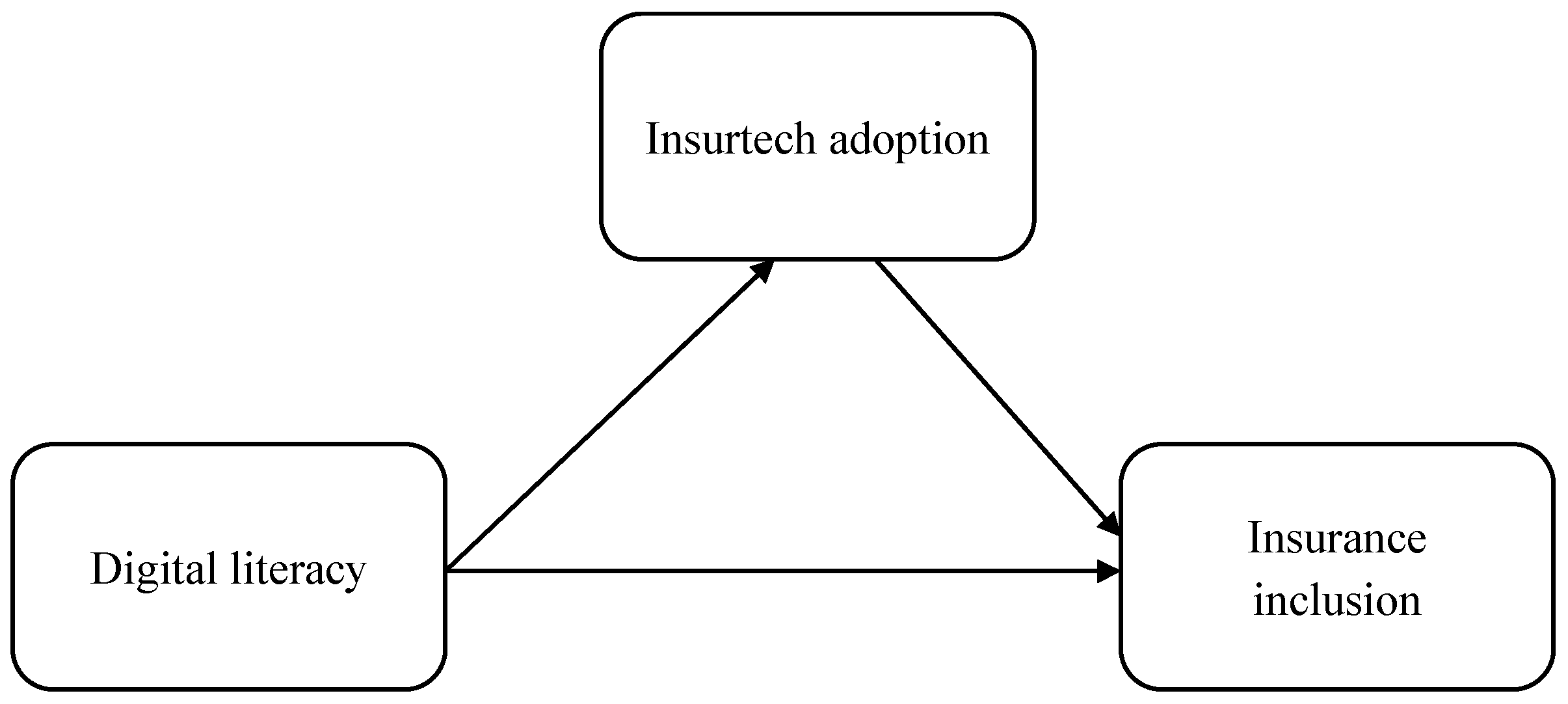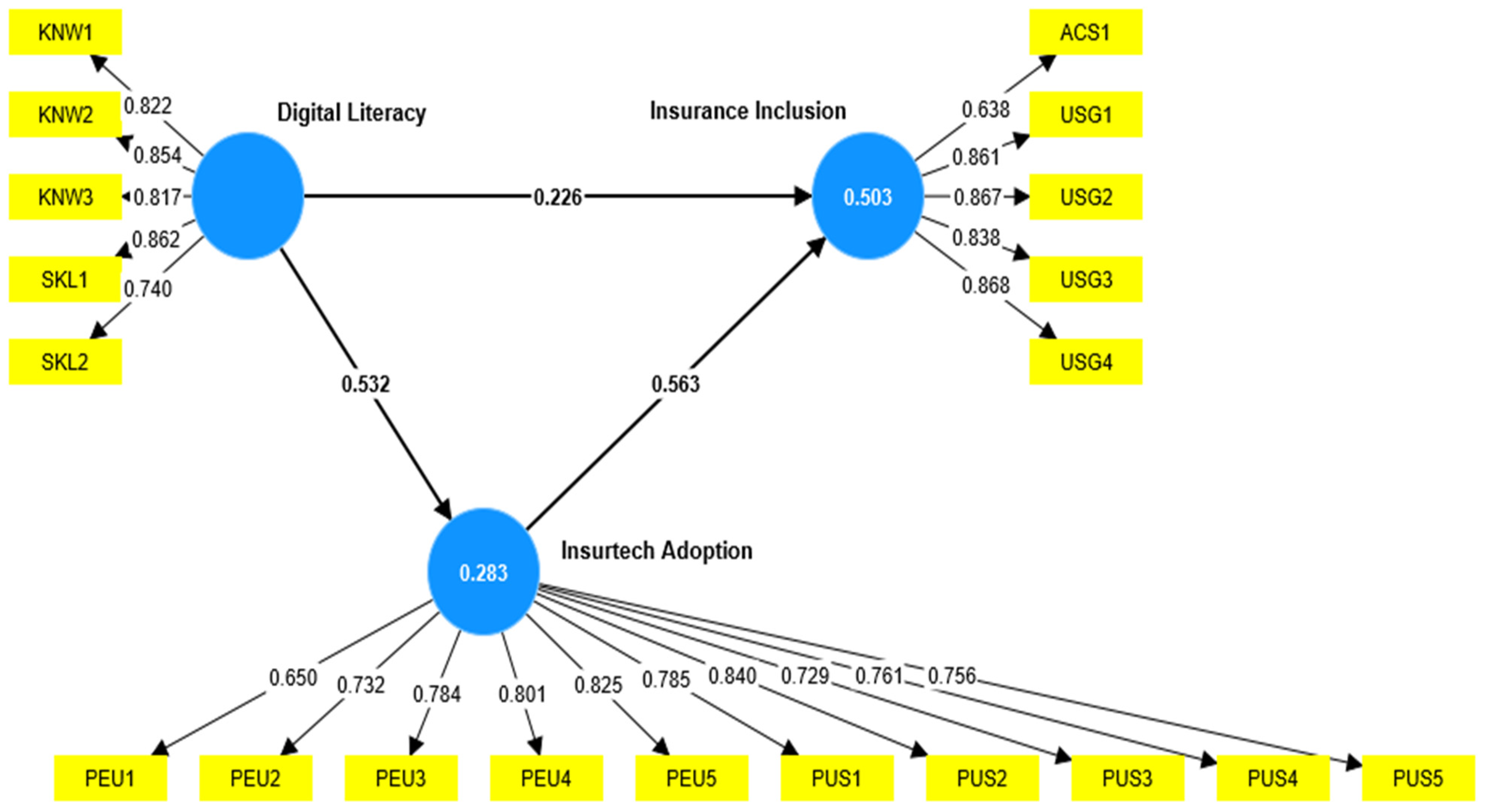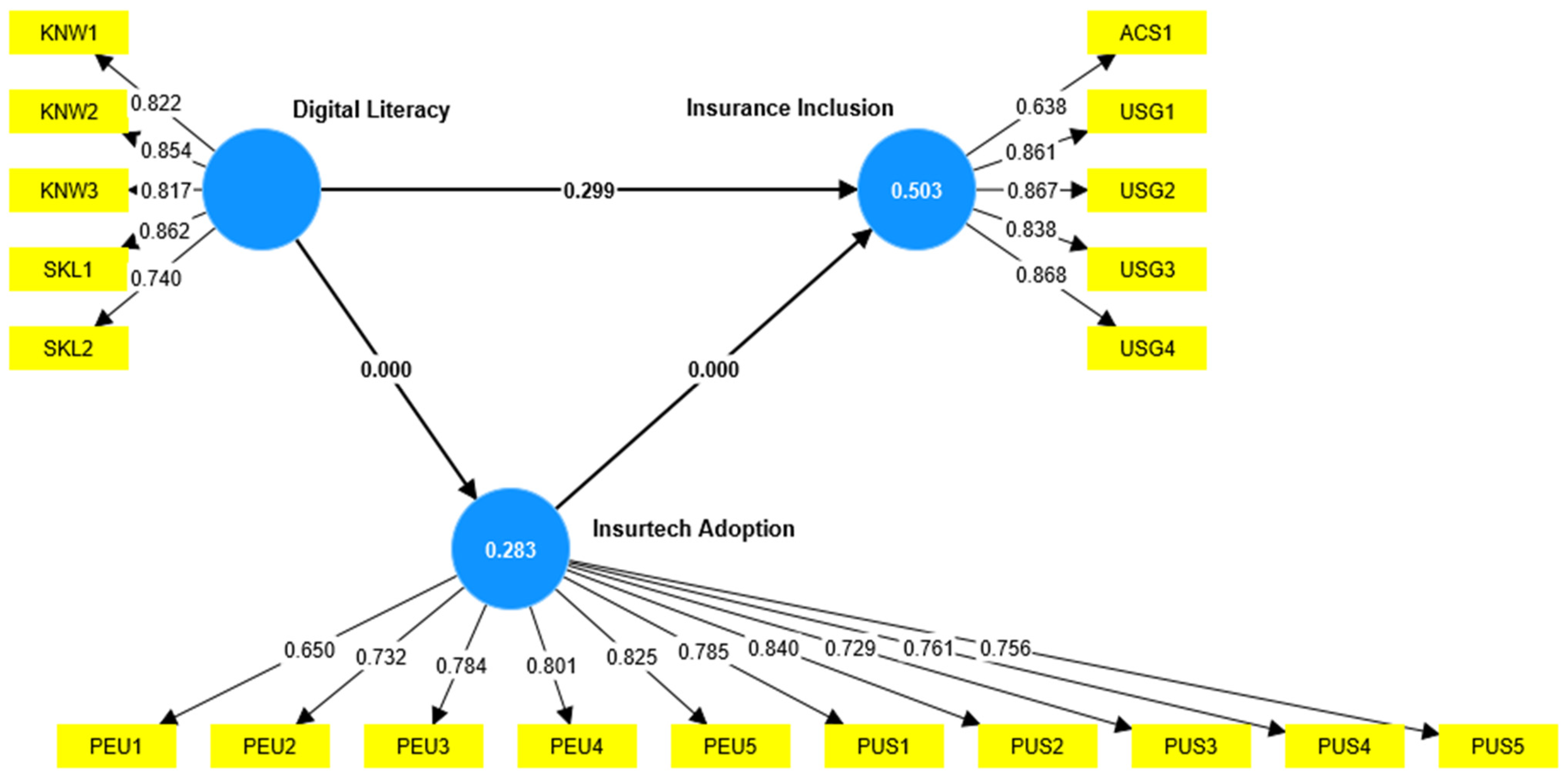Digital Literacy, Insurtech Adoption and Insurance Inclusion in Uganda
Abstract
1. Introduction
2. Literature Review and Hypothesis Development
2.1. Theoretical Review
2.2. Hypothesis Development
2.2.1. Digital Literacy and Insurance Inclusion
2.2.2. Insurtech Adoption and Insurance Inclusion
2.2.3. Digital Literacy and Insurtech Adoption
3. Research Methodology
4. Empirical Results Presentation and Analysis
4.1. Diagnostic Results
4.2. Sample Characteristics
4.3. Correlational Analysis
4.4. Structural Equation Modelling Results
5. Discussion
6. Conclusions
Author Contributions
Funding
Institutional Review Board Statement
Informed Consent Statement
Data Availability Statement
Conflicts of Interest
Correction Statement
Appendix A. Study Measurement Items
| Digital Literacy | |
| Knowledge | |
| KNW1 | I know how to use digital devices such as smart phones, computers and tablets. |
| KNW2 | I am aware of the threats and risks associated with online services. |
| KNW3 | I know the importance of digital security such as having strong passwords. |
| Skills | |
| SKL1 | I can ably navigate and search for information on the internet |
| SKL2 | I can ably evaluate the credibility of online information |
| Insurtech adoption | |
| Perceived ease of use | |
| PEU1 | I find digital insurance platforms easy to use. |
| PEU2 | I easily learn to use digital insurance platforms. |
| PEU3 | I am confident when using digital insurance platforms. |
| PEU4 | The interface of the digital insurance platform is friendly. |
| PEU5 | I easily learned how to use the digital insurance platform. |
| Perceived Usefulness | |
| PUS1 | The digital insurance platform made purchasing insurance easy. |
| PUS2 | I easily monitor my insurance policy on the digital insurance platform. |
| PUS3 | Digital insurance has made the insurance process efficient. |
| PUS4 | The digital platform has increased the transparency of the insurance provider. |
| PUS5 | Overall, the digital insurance platform has improved my experience with the insurance provider. |
| Insurance inclusion | |
| Access | |
| ACS1 | Digital insurance platforms provide convenient access to insurance products and services. |
| Usage | |
| USG1 | I intend to continue using digital insurance services. |
| USG2 | I would recommend others to buy insurance using digital platforms. |
| USG3 | The digital insurance platform has a wide variety of insurance products and services. |
| USG5 | I feel good about my decision to buy insurance through a digital platform. |
References
- Ajzen, Icek, and Martin Fishbein. 2000. Attitudes and the attitude-behaviour relation: Reasoned and automatic processes. European Review of Social Psychology 11: 1–33. [Google Scholar] [CrossRef]
- Asif, Mohammad, Mohd Naved Khan, Sadhana Tiwari, Showkat K. Wani, and Firoz Alam. 2023. The impact of fintech and digital financial services on financial inclusion in India. Journal of Risk and Financial Management 16: 122. [Google Scholar] [CrossRef]
- Asongu, Simplice A., and Nicholous M. Odhiambo. 2020. Insurance policy thresholds for economic growth in Africa. European Journal of Development Research 32: 672–89. [Google Scholar] [CrossRef]
- Bayar, Yilmaz, Marius Dan Gavriletea, and Dan Constantine Danuletiu. 2021. Does the insurance sector really matter for economic growth? Evidence from Central and Eastern European countries. Journal of Business Economics and Management 22: 695–713. [Google Scholar] [CrossRef]
- Beck, Thorsten. 2020. Fintech and Financial Inclusion: Opportunities and Pitfalls. Retrieved from Social Science Premium Collection. Tokyo: Asian Development Bank Institute. Available online: https://search.proquest.com/docview/2487312988 (accessed on 11 September 2023).
- Bittini, Javier Sada, Salvador Cruz Rambaud, Joaquin Lopez Pascual, and Roberto Moro-Visconti. 2022. Business models and sustainability plans in the FinTech, Insurtech, and PropTech industry: Evidence from Spain. Sustainability 14: 12088. [Google Scholar] [CrossRef]
- Chan, Rebecca, Indrit Troshani, Sally Rao Hill, and Arvid Hoffmann. 2022. Towards an understanding of consumers’ FinTech adoption: The case of open banking. International Journal of Bank Marketing 40: 886–917. [Google Scholar] [CrossRef]
- Cheston, Susy, Sonja Kelly, Allyse McGrawth, Conan French, and Dennis Ferenzy. 2018. Insurance Inclusion: Closing the Protection Gap for Emerging Customers. Washington, DC: Center for Financial Inclusion. [Google Scholar]
- Davis, D. Fred. 1989. Perceived usefulness, perceived ease of use, and user acceptance of information technology. MIS Quarterly 13: 319–40. [Google Scholar] [CrossRef]
- Demirgüç-Kunt, Asli, Leora Klapper, Dorothe Singer, and Saniyar Ansar. 2022. The Global Findex Database 2021. Chicago: World Bank Publications. [Google Scholar] [CrossRef]
- Demirgüç-Kunt, Asli, Leora Klapper, Dorothe Singer, Saniyar Ansar, and Jake Hess. 2018. The Global Findex Database 2017, 1st ed. Washington, DC: World Bank Publications. [Google Scholar] [CrossRef]
- Elkaseh, Ali Mohamed, Kok Wai Wong, and Chun Che Fung. 2016. Perceived ease of use and perceived usefulness of social media for e-learning in Libyan higher education: A structural equation modelling analysis. International Journal of Information and Education Technology 6: 192–99. [Google Scholar] [CrossRef]
- Finscope. 2018. Finscope Survey: Top Line Findings Summary Report. Kampala: Financial Sector Deepening Uganda. [Google Scholar]
- Gautum, Rahul Singh, and Jagjeevan Kanoujiya. 2022. Role of regional rural banks in rural development and its influences on digital literacy in India. IRE Journals 5: 92–101. [Google Scholar]
- Gie, Tung An, and Chung Jee Fenn. 2019. Technology acceptance model and digital literacy of first-year students in a private institution of higher learning in Malaysia. Berjaya Journal of Services & Management 11: 103–16. [Google Scholar]
- Hair, Joseph F., William C. Black, Barry J. Babin, and Rolph E. Anderson. 2019. Multivariate Data Analysis, 8th ed. Boston: Cengage Learning, EMEA. [Google Scholar]
- Hassan, Rashedul, Muhammad Ashfaq, Tamiza Parveen, and Ardi Gunardi. 2022. Financial inclusion—Does digital financial literacy matter for women entrepreneurs. International Journal of Social Economics 20: 1085–104. [Google Scholar] [CrossRef]
- Holliday, Susan. 2019. How Insurtech Can Close the Protection Gap in Emerging Markets. Washington, DC: International Finance Corporation. Available online: http://hdl.handle.net/10986/32366 (accessed on 5 June 2023).
- Insurance Regulatory Authority. 2022. Annual Insurance Market Report. Kampala: Insurance Regulatory Authority. [Google Scholar]
- International Association of Insurance Supervisors. 2022. IAIS Global Insurance Market Report 2022 Highlights Key Risks and Trends Facing the Global Insurance Sector. Targeted News Service. Available online: https://search.proquest.com/docview/2754850078 (accessed on 16 December 2022).
- Jang, Monkyoung, Milla Aavakare, Shahrokh Nikou, and Seongcheol Kim. 2021. The impact of literacy on intention to use digital technology for learning: A comparative study of Korea and Finland. Telecommunications Policy 45: 102154. [Google Scholar] [CrossRef]
- Kabakus, Ahmet Kamil, Ekrem Bahcekapili, and Ahmet Ayaz. 2023. The effect of digital literacy on technology acceptance: An evaluation on administrative staff in higher education. Journal of Information Science. [Google Scholar] [CrossRef]
- Kanga, Desire, Christine Oughton, Laurence Harris, and Victor Murinde. 2022. The diffusion of fintech, financial inclusion and income per capita. The European Journal of Finance 28: 108–36. [Google Scholar] [CrossRef]
- Kass-Hanna, Josephine, Angella C. Lyons, and Fan Liu. 2022. Building financial resilience through financial and digital literacy in south Asia and sub-Saharan Africa. Emerging Markets Review 51: 100846. [Google Scholar] [CrossRef]
- Kim, Minjin, Hanan Zoo, Heejin Lee, and Juhee Kang. 2018. Mobile financial services, financial inclusion, and development: A systematic review of academic literature. The Electronic Journal of Information Systems in Developing Countries 84: e12044. [Google Scholar] [CrossRef]
- Kiwanuka, Archillies, and Atheni Bongani Sibindi. 2023. Insurance inclusion in Uganda: Impact of perceived value, insurance literacy and perceived trust. Journal of Risk and Financial Management 16: 81. [Google Scholar] [CrossRef]
- Lin, Lin, and Christopher Chen. 2020. The promise and perils of Insurtech. Singapore Journal of Legal Studies 2020: 115–42. [Google Scholar] [CrossRef]
- Lyons, Angela C., and Josephine Kass-Hanna. 2021. A methodological overview to defining and measuring “digital” financial literacy. Financial Planning Review 4: e1113. [Google Scholar] [CrossRef]
- Lyons, Angela C., Josephine Kass-Hanna, and Andrew Greenlee. 2020. Impacts of Financial and Digital Inclusion on Poverty in South Asia and Sub-Saharan Africa. SSRN. Available online: https://papers.ssrn.com/sol3/papers.cfm?abstract_id=3684265 (accessed on 11 November 2023). [CrossRef]
- Mikheev, Alexey, Yana Serkina, and Alexander Vasyaev. 2023. Current trends in the digital transformation of higher education institutions in Russia. Education and Information Technologies 26: 4537–51. [Google Scholar] [CrossRef]
- Moenjak, Thammarak, Anyarat Kongprajya, and Chompoonoot Monchaitrakul. 2020. FinTech, Financial Literacy, and Consumer Saving and Borrowing: The Case of Thailand. Retrieved from Social Science Premium Collection. Tokyo: Asian Development Bank Institute. Available online: https://search.proquest.com/docview/2423771629 (accessed on 7 October 2023).
- Mohammadyari, Soheila, and Harminder Singh. 2015. Understanding the effect of e-learning on individual performance: The role of digital literacy. Computers and Education 82: 11–25. [Google Scholar] [CrossRef]
- Morgan, Peter, Long Trinh, and Bihong Huang. 2019. The Need to Promote Digital Financial Literacy for the Digital Age. Washington, DC: International Monetary Fund. [Google Scholar]
- Nikou, Shahrokh, and Milla Aavakare. 2021. An assessment of the interplay between literacy and digital technology in higher education. Education and Information Technologies 26: 3893–915. [Google Scholar] [CrossRef]
- Nikou, Shahrokh, Mark De Reuver, and Matin Mahboob Kanafi. 2022. Workplace literacy skills—How information and digital literacy affect adoption of digital technology. Journal of Documentation 78: 371–91. [Google Scholar] [CrossRef]
- Prasad, Hanuma, Devendra Meghwal, and Vijay Dayama. 2018. Digital financial literacy: A study of households of Udaipur. Journal of Business and Management 5: 23–32. [Google Scholar] [CrossRef]
- Rahayu, Ritah, Syahril Ali, Amalda Aulia, and Retnoningrum Hidayah. 2022. The current digital financial literacy and financial behaviour in Indonesian millennial generation. Journal of Accounting and Investment 23: 78–94. [Google Scholar] [CrossRef]
- Reddy, Pritika, Bibhya Sharma, and Kaylash Chaudhary. 2020. Digital literacy: A review of literature. International Journal of Techno Ethics 11: 65–94. [Google Scholar] [CrossRef]
- Rosyadah, Khairina, Budiandriani Budiandriani, and Tasrik Hasrat. 2021. The role of fintech: Financial inclusion in MSMEs (case study in Makassar city). Jurnal Manajemen Bisnis 8: 268–75. [Google Scholar] [CrossRef]
- Sahay, Ratna. 2020. The Promise of Fintech. Washington, DC: International Monetary Fund. [Google Scholar]
- Setiawan, Maman, Nury Effendi, Teguh Santoso, Vera Intanie Dewi, and Militcyano Samuel Sapulette. 2022. Digital financial literacy, current behavior of saving and spending and its future foresight. Economics of Innovation and New Technology 31: 320–38. [Google Scholar] [CrossRef]
- Sibindi, Athenia Bongani. 2022. Information and communication technology adoption and life insurance market development: Evidence from Sub-Saharan Africa. Journal of Risk and Financial Management 15: 568. [Google Scholar] [CrossRef]
- Van der Cruijsen, Carin, Jacob de Haan, and Ria Roerink. 2021. Financial knowledge and trust in financial institutions. Journal of Consumer Affairs 55: 680–714. [Google Scholar] [CrossRef]
- Wang, Qing, Chengjun Liu, and Sai Lan. 2022. Digital literacy and financial market participation of middle-aged and elderly adults in China. Economic and Political Studies, 1–28, ahead-of-print. [Google Scholar]
- Yamane, Tarro. 1973. Statistics, 3. ed., 1. print. ed. Manhattan: Harper & Row. [Google Scholar]
- Zulfiqar, Umera, Sajid MohY-Ul-Din, Ayman Abu-Rumman, Ata E. M. Al-Shraah, and Israr Ahmed. 2020. Insurance-growth nexus: Aggregation and disaggregation. The Journal of Asian Finance, Economics, and Business 7: 665–75. [Google Scholar] [CrossRef]



| Variables | Composite Reliability | Average Variance Extracted (AVE) | Content Validity Index (CVI) |
|---|---|---|---|
| Digital Literacy | 0.878 | 0.673 | 0.750 |
| Insurtech Adoption | 0.922 | 0.590 | 0.800 |
| Insurance Inclusion | 0.873 | 0.671 | 0.833 |
| Variables | Heterotrait–Monotrait Ratio (HTMT) | Variance Inflation Factors (VIFs) |
|---|---|---|
| Insurance Inclusion -> Digital Literacy | 0.601 | 1.394 |
| Insurtech Adoption -> Insurance Inclusion | 0.590 | 1.000 |
| Digital Literacy -> Insurtech Adoption | 0.756 | 1.394 |
| Frequency | % | |
| Gender | ||
| Male | 168 | 42.9 |
| Female | 223 | 57.1 |
| Total | 391 | 100 |
| Age | ||
| 18–33 years | 179 | 45.7 |
| 34–49 years | 194 | 49.7 |
| 50–65 years | 18 | 4.6 |
| Total | 391 | 100.0 |
| Education Level | ||
| Primary Leaving Examination (PLE) | 0 | 0 |
| Uganda Certificate of Education (UCE) | 10 | 2.6 |
| Uganda Advanced Certificate of Education (UACE) | 20 | 5.1 |
| Diploma | 57 | 14.6 |
| Degree | 257 | 65.7 |
| Master’s Degree | 42 | 10.7 |
| PhD | 5 | 1.3 |
| Total | 391 | 100 |
| Frequency | % | |
| Gadget Used to Access insurance | ||
| Mobile Phone | 358 | 91.6 |
| Computer | 33 | 8.4 |
| Total | 391 | 100 |
| Variables | 1 | 2 | 3 | 4 | 5 | 6 | 7 | 8 | 9 |
|---|---|---|---|---|---|---|---|---|---|
| Knowledge (1) | 1 | ||||||||
| Skills (2) | 0.784 ** | 1 | |||||||
| Perceived Ease of Use (3) | 0.502 ** | 0.497 ** | 1 | ||||||
| Perceived Usefulness (4) | 0.462 ** | 0.445 ** | 0.813 ** | 1 | |||||
| Access (5) | 0.365 ** | 0.443 ** | 0.407 ** | 0.409 ** | 1 | ||||
| Usage (6) | 0.464 ** | 0.477 ** | 0.651 ** | 0.625 ** | 0.492 ** | 1 | |||
| Digital Literacy (7) | 0.965 ** | 0.920 ** | 0.528 ** | 0.481 ** | 0.419 ** | 0.496 ** | 1 | ||
| Insurtech Adoption (8) | 0.505 ** | 0.494 ** | 0.948 ** | 0.956 ** | 0.429 ** | 0.669 ** | 0.532 ** | 1 | |
| Insurance Inclusion (9) | 0.488 ** | 0.520 ** | 0.656 ** | 0.634 ** | 0.686 ** | 0.971 ** | 0.525 ** | 0.683 ** | 1 |
| Hypothesised Path | Path Coefficient | Standard Dev. | t-Values | p Values | Decision |
|---|---|---|---|---|---|
| Digital Literacy -> Insurance Inclusion | 0.226 | 0.057 | 3.940 | 0.000 | Supported |
| Insurtech Adoption -> Insurance Inclusion | 0.563 | 0.045 | 12.634 | 0.000 | Supported |
| Digital Literacy -> Insurtech Adoption | 0.532 | 0.039 | 13.526 | 0.000 | Supported |
| Digital Literacy -> Insurtech Adoption -> Insurance Inclusion | 0.299 | 0.034 | 8.884 | 0.000 | Supported |
Disclaimer/Publisher’s Note: The statements, opinions and data contained in all publications are solely those of the individual author(s) and contributor(s) and not of MDPI and/or the editor(s). MDPI and/or the editor(s) disclaim responsibility for any injury to people or property resulting from any ideas, methods, instructions or products referred to in the content. |
© 2024 by the authors. Licensee MDPI, Basel, Switzerland. This article is an open access article distributed under the terms and conditions of the Creative Commons Attribution (CC BY) license (https://creativecommons.org/licenses/by/4.0/).
Share and Cite
Kiwanuka, A.; Sibindi, A.B. Digital Literacy, Insurtech Adoption and Insurance Inclusion in Uganda. J. Risk Financial Manag. 2024, 17, 119. https://doi.org/10.3390/jrfm17030119
Kiwanuka A, Sibindi AB. Digital Literacy, Insurtech Adoption and Insurance Inclusion in Uganda. Journal of Risk and Financial Management. 2024; 17(3):119. https://doi.org/10.3390/jrfm17030119
Chicago/Turabian StyleKiwanuka, Archillies, and Athenia Bongani Sibindi. 2024. "Digital Literacy, Insurtech Adoption and Insurance Inclusion in Uganda" Journal of Risk and Financial Management 17, no. 3: 119. https://doi.org/10.3390/jrfm17030119
APA StyleKiwanuka, A., & Sibindi, A. B. (2024). Digital Literacy, Insurtech Adoption and Insurance Inclusion in Uganda. Journal of Risk and Financial Management, 17(3), 119. https://doi.org/10.3390/jrfm17030119







